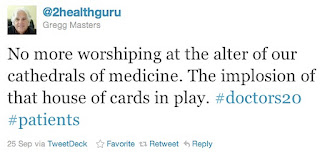
A version of this article was published in the January+February 2012 issue of interactions magazine.
I've been reviewing an excellent manuscript for a book on design thinking and reading about a new game and kit developed by IDEO to help explain it. These things delight me, since for years, I've been focused on expanding the role of design/UX to be a full participant in defining business strategy and in being a catalyst for that change. More recently, participation in defining social strategy became an important part of that focus. Design thinking came to be advocated by business visionaries to be a major part of a fix to a broken strategy definition process. Jon Kolko and I published our and others' writings about such things in interactions when we were Co-Editors-in-Chief.
So, I have been intrigued by proclamations that design thinking is a failed experiment, that it is misguided to attempt to describe the process, and that design thinking must be recognized as the purview of the trained designer. Innumerable attempts at explaining the usually less ambitious "user-centered design" have been greeted by similar negative reactions over the years.
Just what is going on here? Why the negative reactions? Sometimes stepping aside to look at comparable happenings in a seemingly different context can provide some insight, so allow me to describe some of what is happening in the world of healthcare.
In today's world of healthcare, a ballooning number of patients seek at minimum full participation in defining their diagnostic/treatment strategy. Why? Because of an outrageous number of medical misdiagnoses, because of what is often an insulting patient experience involving doctors who don't listen to or even bother to touch their patients anymore, because doctors tend to just "regurgitate (knowledge) rather than think" and disregard limits to their knowledge and experience, because a system of referrals and approvals prevents direct and ready access to doctors with needed expertise, ... -- in short, because of a healthcare system declared to be "broken" by speaker after speaker at Medicine 2.0'11 held at the Stanford University Medical Center.
Patient efforts to meaningfully pierce the diagnostic/treatment process have been greeted with claims that patients lack the skills/training to do this successfully, that only doctors can diagnose and prescribe correctly, that anything patients learn via the internet is highly suspect, that reducing diagnosis/treatment to a process in which patients can participate ignores the fact that the practice of medicine is as much of an art as a science, ... -- reasons coming from members of a community (i.e., doctors) classified as a stage 3 (of 5) tribe: "I'm great, and you're not."
You should be seeing a lot of parallels...
In spite of proclamations against greater participation of patients, the "epatient" movement is growing rapidly, with peer-to-peer healthcare increasingly seen as an essential part of a fully functional healthcare system in which social media play vital roles. A Society for Participatory Medicine has been formed as part of this movement "in which networked patients shift from being mere passengers to responsible drivers of their health, and in which providers encourage and value them as full partners." I'm even seeing suggestions of a need for an "Occupy Healthcare" movement. Meanwhile, medical rebels such as Jay Parkinson are showing how a patient-centered healthcare practice can work in spite of active resistance from the medical community, and programs are being designed to train medical students how to listen and talk to patients.
The following observation by an attendee of Health 2.0 San Francisco 2011 speaks to all of this:

And as I write this, the Occupy Wall Street protests are going global. As Thomas Friedman states in The New York Times:
"Occupy Wall Street is like the kid in the fairy story saying what everyone knows but is afraid to say: the emperor has no clothes. The system is broken."
Indeed, the businesses in which many of you work are broken, operating and/or structured in ways more appropriate for an earlier era. Many of these businesses are faced with the need to become genuninely user- or customer-centered and connected/social. To achieve this, design/UX leadership is badly needed. However, as Samantha Starmer warned after learning that design/UX personnel are not the ones getting the many newly created Chief Customer Officer positions:
"Given the current power of CX at the C-level, UX practitioners must step up our game, otherwise we will lose progress we have made to be more deeply involved in strategy beyond just performing usability services. We need to act now to be part of the broader CX solution. If we don't proactively collaborate across divisions and organizational structures, we will be stuck playing in the corner by ourselves. If we don'f figure out how to manage partnerships with other departments in a collaborative, creatice, customer focused way, the discipline of UX as we know it is at risk. CX management will take over."
New social, user/customer-centered businesses are needed. "Citizen-centered" social strategy is needed. And design (thinking) can lead the way.
Describing/explaining the design process for others to understand -- to enable their effective participation -- is essential for this to happen. However, more educational programs akin to that provided by the Austin Center for Design are needed. Perhaps a new professional association -- a resurrection of a sort of Computer Professionals for Social Responsibility -- fully focused on this kind of participatory design would be helpful.
We've reached the point of no more worshiping at the altar of our cathedrals of business. The marginalization of design (thinking) and UX is finally on its way to the rag pile.
It is a very good time to be a design( think)er.


